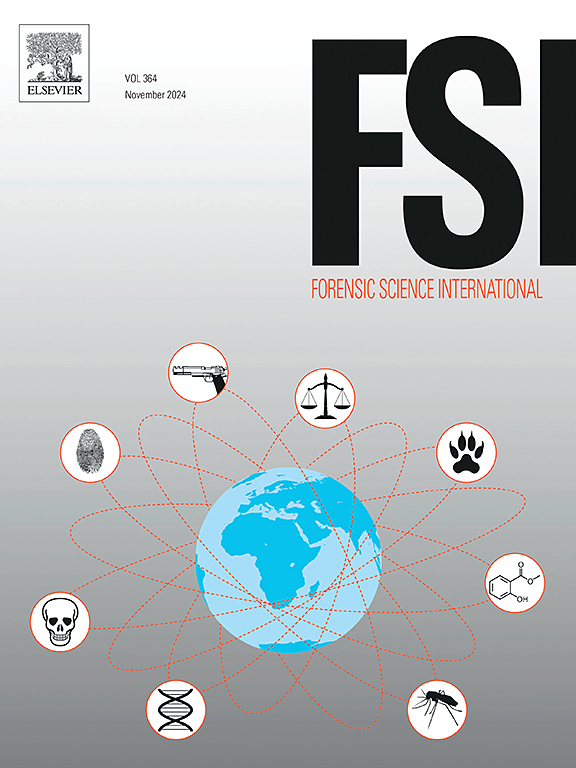Determination of endogenous GHB in ante-mortem whole blood, urine, and oral fluid by LC–MS/MS: The effect of different additives and storage conditions on the stability of GHB in blood
IF 2.2
3区 医学
Q1 MEDICINE, LEGAL
引用次数: 0
Abstract
Two challenges in detecting γ-hydroxybutyric acid (GHB) intake are its endogenous presence and in vitro production after sampling. This study developed an LC–MS/MS method for selective GHB determination in human antemortem blood, urine, and oral fluid at endogenous concentrations. Furthermore, the stability of GHB in blood samples and its endogenous concentrations in samples taken under controlled circumstances were investigated. Samples were extracted in methanol/acetonitrile and processed by anion exchange solid-phase extraction. GHB was separated from structural isomers using a reversed–phase LC column with anion properties. The validated limit of quantification was 0.005 µg/mL in blood and 0.010 µg/mL in urine and oral fluid, at which the relative reproducibility standard deviation and bias were <15 %. The mean extraction recovery was ≥90 %. The average GHB concentration increased by 1.2 µg/mL in fluoride/citrate- preserved blood after 28 days of storage at 4°C; however, in fluoride/oxalate (FX)-preserved blood, the mean concentration increased by only 0.055 µg/mL. No change was observed at −20°C. In 105 randomly selected samples of FX-preserved blood collected for forensic antemortem toxicological analysis, all concentrations were <0.066 µg/mL, even after long-term storage at −20°C. In blood, urine, and oral fluid samples from a clinical study of GHB intake, endogenous baseline levels from 30 participants ranged from 0.0069–0.050, 0.024–0.38, and 0.034–0.93 µg/mL, respectively. These results demonstrate that the current cut-off level of 5 µg/mL for discriminating between endogenous and exogenous GHB in antemortem blood could be considerably lower for FX-preserved blood stored at −20°C.
利用LC-MS/MS测定死前全血、尿液和口服液中的内源性伽马--羟丁酸:不同添加剂和储存条件对血液中伽马--羟丁酸稳定性的影响
检测γ-羟丁酸(GHB)摄入量的两个难题是其内源性存在和采样后的体外生成。本研究开发了一种 LC-MS/MS 方法,用于选择性地检测人体死前血液、尿液和口服液中内源性浓度的 GHB。此外,还研究了血液样本中 GHB 的稳定性以及在受控情况下采集样本中 GHB 的内源性浓度。样品在甲醇/乙腈中提取,并通过阴离子交换固相萃取法进行处理。使用具有阴离子特性的反相液相色谱柱从结构异构体中分离出 GHB。血液中的有效定量限为 0.005 µg/mL,尿液和口服液中的有效定量限为 0.010 µg/mL,相对重现性标准偏差和偏差为 15%。平均提取回收率≥90%。在 4°C 下保存 28 天后,氟化物/柠檬酸盐保存的血液中 GHB 的平均浓度增加了 1.2 µg/mL;但在氟化物/草酸盐(FX)保存的血液中,平均浓度仅增加了 0.055 µg/mL。在 -20°C 下则未观察到任何变化。在为法医尸检毒理学分析而随机抽取的 105 份 FX 保存血液样本中,即使在 -20°C 长期储存后,所有浓度仍为 0.066 µg/mL。在一项关于伽马--羟丁酸摄入量的临床研究中,30 名参与者的血液、尿液和口腔液样本中的内源性基线水平分别为 0.0069-0.050、0.024-0.38 和 0.034-0.93 微克/毫升。这些结果表明,目前用于鉴别死前血液中内源性和外源性 GHB 的 5 µg/mL 临界值,对于储存在 -20°C 的 FX 保存血液来说可能要低得多。
本文章由计算机程序翻译,如有差异,请以英文原文为准。
求助全文
约1分钟内获得全文
求助全文
来源期刊

Forensic science international
医学-医学:法
CiteScore
5.00
自引率
9.10%
发文量
285
审稿时长
49 days
期刊介绍:
Forensic Science International is the flagship journal in the prestigious Forensic Science International family, publishing the most innovative, cutting-edge, and influential contributions across the forensic sciences. Fields include: forensic pathology and histochemistry, chemistry, biochemistry and toxicology, biology, serology, odontology, psychiatry, anthropology, digital forensics, the physical sciences, firearms, and document examination, as well as investigations of value to public health in its broadest sense, and the important marginal area where science and medicine interact with the law.
The journal publishes:
Case Reports
Commentaries
Letters to the Editor
Original Research Papers (Regular Papers)
Rapid Communications
Review Articles
Technical Notes.
 求助内容:
求助内容: 应助结果提醒方式:
应助结果提醒方式:


